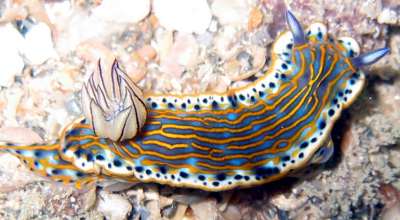
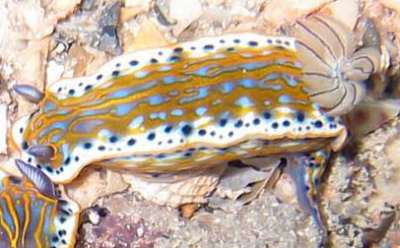
Hypselodoris bayeri
(Marcus & Marcus, 1967)
Order: NUDIBRANCHIA
Suborder: DORIDINA
Superfamily: EUDORIDOIDEA
Family: Chromodorididae
DISTRIBUTION
Caribbean
PHOTO
Virginia Key, Biscayne Bay, Florida, USA. Depth: 20 ft. Length: 2-3 cm. Photographer: Phillip Gillette.
This species was described from two preserved specimens, and an accompanying colour slide from Virginia Key, Florida. Because there is some confusion as to the indentity of this species, I have copied the original colour description verbatim:
'The color alive (based on a photograph) is: notum blue with 6-10 longitudinal anastomosing orange yellow lines edged with black, the more lateral ones often interrupted. The margin of the notum is white, indistinctly set off from the blue ground color, containing black spots of different size, and bordered by a yellow line externally. There is a yellow circle around the blue rhinophores. The gills are colorless with a black line alone the atterent vessel and a yellow with black one alone the efferent vessel. The tail is white with orange yellow lines and black spots, edged with blue. The sides of the foot bear yellow stripes.'
I have had my doubts about many of the animals identified as H. bayeri in the literature. None of them have fitted the original description very well. Phillip Gillette's upper photo however the Marcus's description almost exactly. From the lower photo we can see that the colour obviously varies from animals with a number of thin yellow longitudinal lines down the mantle, each outlined in black as in Marcus's description, to animals in which the yellow lines are less clear and the blue spots more dominant, as in your photo alongside. It is possible that the animal from the Virgin Ids [see message #7999] is an extreme colour form.
-
Marcus, Er. & Marcus, Ev. (1967) American opisthobranch mollusks. Part 1, Tropical American opisthobranchs. Studies Tropical Oceanography, Miami, 6(1-2): 1-137. (Figs 1-150, Pl.1, figs 1-9).
Rudman, W.B., 2005 (February 2) Hypselodoris bayeri (Marcus & Marcus, 1967). [In] Sea Slug Forum. Australian Museum, Sydney. Available from http://www.seaslugforum.net/find/hypsbaye
Related messages
Re: Hypselodoris bayeri in Curacao
January 18, 2010
From: Terence Zahner
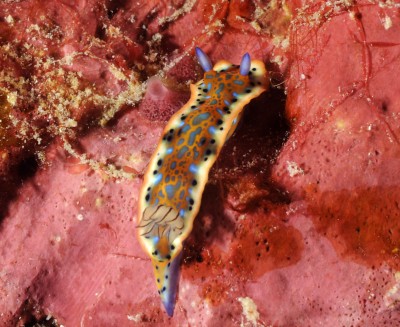
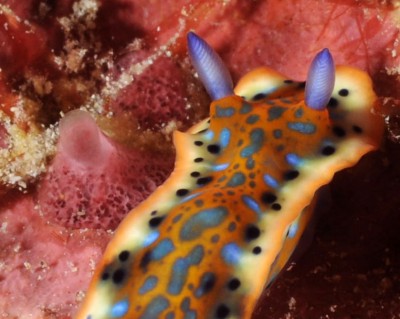
Concerning message #23065:
Hi Bill
Sharp eyes! I have attached the whole series of images I shot. In the first two, there also appears to be some orange sponge growth in the center of the frame. You can see a little of the nudibranch's direction of travel.
I also pointed this out to another photographer I was diving with. He may have gotten a different perspective or a better shot of the surroundings. I'll ask him.
Terence
tzahner@gmail.com
Zahner, T., 2010 (Jan 18) Re: Hypselodoris bayeri in Curacao. [Message in] Sea Slug Forum. Australian Museum, Sydney. Available from http://www.seaslugforum.net/find/23117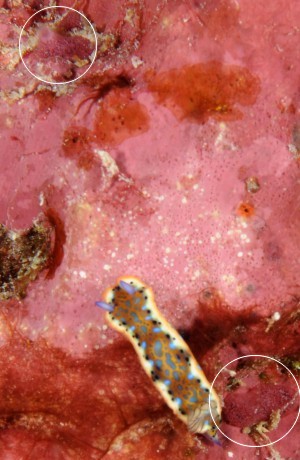
Dear Terence,
Thanks for your rapid response. I have included two photos above, which are from the last of your sequence of photos and show the nudibranch alongside the sponge siphon. I first thought it looked as though the Hypselodoris was aiming for this sponge siphon but then I noticed that in the first photo in your sequence, when the slug is furthest from the siphon, it is moving past another small colony of the same sponge [see rings in lower photo].
In your close-up, the fibrous skeleton doesn't seem right for the most likely families this animal would eat, so I think it is all just a coincidence.
Your effort is certainly not a waste of time, for these animals don't always do what they are supposed to do. If we start to get more records of it associated with this sponge we may need to change our mind.
Best wishes,
Bill Rudman
Hypselodoris bayeri in Curacao
January 14, 2010
From: Terence Zahner
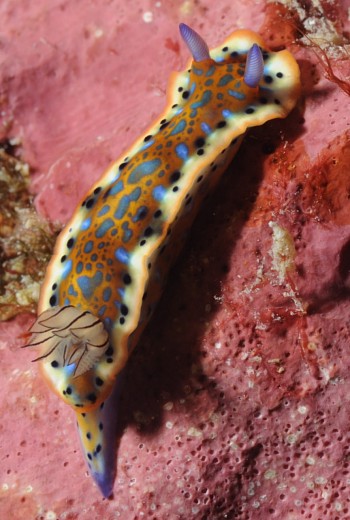
Hi Bill
I observed this specimen last week. It appears to match the picture of Hypselodoris cf. acriba at the bottom of page 160 of Caribbean Sea Slugs, but Curacao is not included in the geographic range.
Locality: Playa Kalki, Westpunt, 38 feet, Curacao, Netherlands Antilles, Caribbean Sea, 29 December 2009, Reef. Length: 30 mm (approx). Photographer: Terence Zahner.
Terence Zahner
tzahner@gmail.com
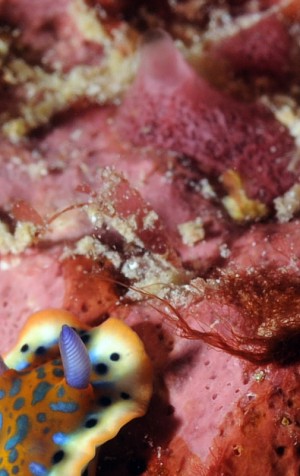
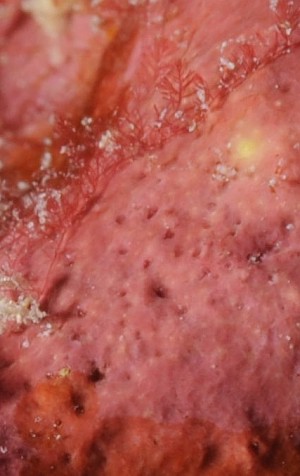
Dear Terence,
If you look at the messages attached to the Hypselodoris bayeri Fact Sheet you will see that I suspect this to be a colour form of H. bayeri rather than of H. acriba [see message #22632 for example]. Unfortunately the original descriptions of these two species were not that clear, and both seem to be variable in colour, but I think my interpretation fits the descriptions better. Unfortunately a lot more fieldwork is needed before some of the identification problems with Caribbean species can be sorted out.
Whatever its name, I am interested in what sponges these nudibranchs feed on. I first thought the pink colour in your photos was a thin layer of coralline algae over the underlying rock but I noticed a sponge siphon [see top of lower left close-up] so I suspect the whole of the substrate is covered with a thin sponge layer. If by chance you have other photos taken at the same time, perhaps you could have a look and see if you have any that show the sponge in more detail?
Best wishes,
Bill Rudman
Re: Hypselodoris acriba or H. bayeri?
August 31, 2009
From: Wayne Atkinson
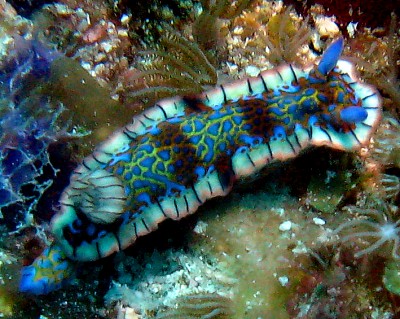
Concerning message #16899:
Dear Bill,
Further to Valda Bromfield's and Eveline Marcus' photos of Hypselodoris bayeri from the Virgin Islands I attach a couple of shots of the same animal, again from the Virgin islands. It seems this colour morph (if that is what it is) with the lines around the mantle is the norm here - I hope these are useful/of interest.
Locality: Mercurious Rock, 12 metres, Jost Van Dyke, BVI, Caribbean Sea, 28 August 2009, rock reef. Length: 2 inches. Photographer: Wayne Atkinson.
Wayne Atkinson
wl.atkinson@gmail.com
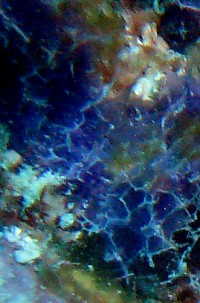
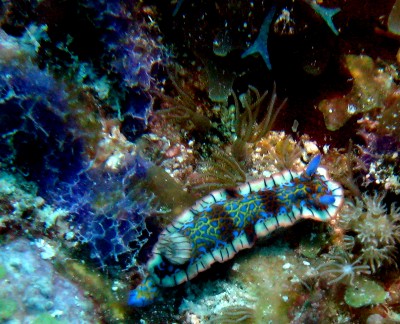
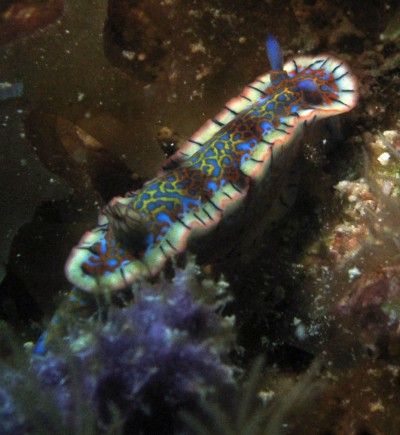
Dear Wayne,
More photos of these puzzling caribbean chromodorids are always welcome. Although photos alone will not resolve the puzzles, I have found them extremely valuable in the past when you are trying to formulate the question to ask. For example can the animals I am calling H. acriba and H. bayeri on the Forum be just colour forms of one species. And is the animal in Lureen Ferretti's recent message [#22617] also a colour form? One problem is that some of the existing species were not well described, and another problem is that species of Hypselodoris and Chromodoris are well-known mimics, with groups of similarly coloured species evolving in the same geographic region. As I mentioned earlier, [message #7999], Eveline Marcus considered your animal to be a colour form of H. bayeri, while in Carribean Sea Slugs it is considered a possible form of H. acriba.
Your animal could well be associated with the bright blue sponge in your photos - which I suspect is a species of Dysidea. Interestingly this is the same sponge which is illustrated in Carribean Sea Slugs as the food of Hypselodoris sp. 3 - which I suspect is part of the H. bayeri complex. However most species of Hypselodoris feed on dysideid sponges so we can't make too much of them feeding on the same sponge.
Sorting out problems like this can't be done in an a chair 1000s of km away. I suspect what is needed is a local research worker who is able to study populations over a number of years, and record colour variability, study anatomy and biology and has the help of dedicated amateurs who can make extra collections and observations. Visiting researchers, no matter how skilled, can only collect small samples in place and time, and as we can see from the present situation, this can lead to confusion rather than clarification.
-
Valdes, A., Hamann, J., Behrens, D.W. & DuPont, A. 2006. Caribbean Sea Slugs. Sea Challengers.
Best wishes,
Bill Rudman
A new chromodorid from the Caribbean?
August 27, 2009
From: Lureen Ferretti
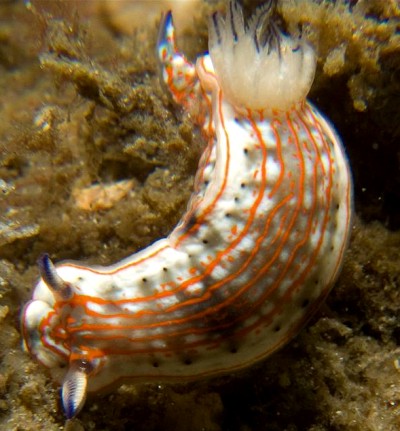
Concerning message #22470:
Hi Bill,
My name is Lureen Ferretti, I dive with Anne Dupont at Lake Worth Lagoon/Phil Foster Park/Blue Heron Bridge - whatever you'd like to call it. :o)
I emailed her my finds for the weekend and she told me this guy is an unidentified nudi. Is that possible ? Have I found a new one ? That is SO exciting. As I'm sure you can tell, I'm still an aspiring photographer but I've attached the 3 best photos I have of this guy. It looks like the yellow-streaked sea goddess, only it has orange streaks.
If you need additional info or more pics, please let me know.
Locality: Lake Worth Lagoon, 20 feet, Florida, United States, Atlantic Ocean, 23 August 2009, rubbly bottom. Length: 1 inch. Photographer: Lureen Ferretti.
Lureen Ferretti.
enchantedpath@comcast.net
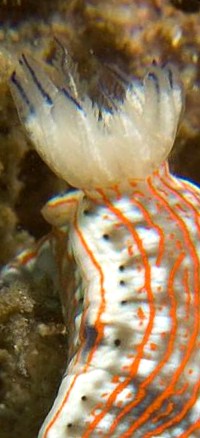
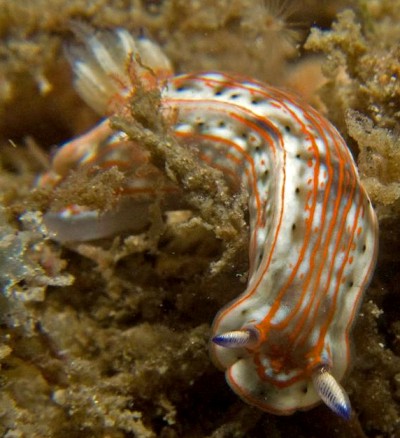
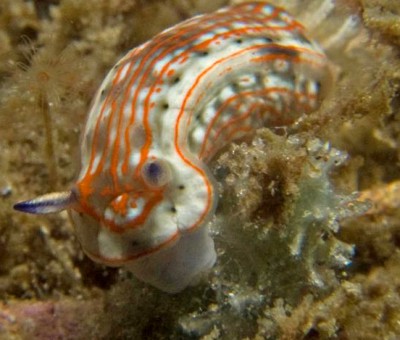
Dear Lureen,
This is an interesting find. From the sponge it is feeding on - a species of Dysidea - and its general shape, I'm pretty sure it is a species of Hypselodoris, and it certainly doesn't appear to fit any named species. On looking through Caribbean Sea Slugs it would appear to be a colour form of the species they call Hypselodoris sp. 3 [pp 164-5]. However, as I discuss in response to Linda's interesting finds in the Chromodoris binza- C. neona group [message #22560], we still have a lot to learn about the Caribbean fauna, and I don't think it helps at this stage to consider or name every new colour pattern as a new species.
Your animal seems to be the same as Ellen Muller's animals from Bonaire [message #21716] which I am calling Hypselodoris bayeri, and Phillip Gillette's photos [message #13022 ] give a good example showing the blue & yellow lines breaking up into spots in different animals. I note that in Caribbean Sea Slugs, H. bayeri is used for the lined animals and H. marci for the spotted forms.
Ones thing they all have in common is that half way down each side of the mantle there is a darker patch and often a darker orange line at the mantle edge. In this way they all have similarities to H. ruthae. The one difference with H. ruthae, is that in that species only the inner edge of the gills is lined with purple. In your animal there is a purple line only at the tip of each gill, but I can't see if it is on the outer edge, inner edge or both. In Ellen Muller's animals both the inner and outer edge of the upper half of the gills is lined purple while in Philip Gillette's both edges of the whole gill are lined. In Caribbean Sea Slugs a distinction is made between purple lines on the rhinophores and purple rhinophores but it seems that in some animals the lines diffuse to cover much of the rhinophore, so this dustinction may not be valid. I can't really say how many species there are at present in this yellow/orange-lined group. What makes it more difficult is that we know that this family is well known for having species mimicking each other in colour pattern.
Ellen Muller has a good photo of the egg ribbon of her colour 'form' and it seems to be the same as that in Caribbean Sea Slugs for their Hypselodoris sp. 3. It would be nice to get photos of egg ribbons from some of the other colour 'forms'. If they are markedly different we would at least know there is more than one species involved.
In short, I don't know if yours is an unnamed species, but whatever it is, it is one more piece of the jig saw puzzle.
-
Valdes, A., Hamann, J., Behrens, D.W. & DuPont, A. 2006. Caribbean Sea Slugs. Sea Challengers.
Best wishes,
Bill Rudman
Hypselodoris bayeri from Bonaire
September 5, 2008
From: Pam McPherson
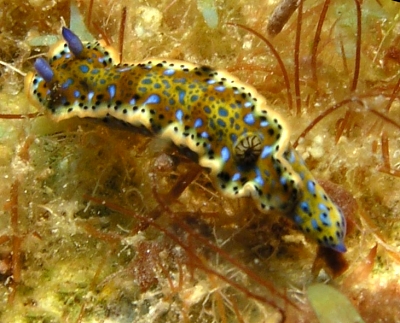
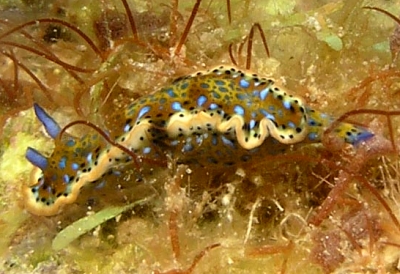
Concerning message #20967:
First dive in Bonaire, I found the attached.
Locality: Lenore, less than 90 feet, Bonaire, Caribbean, 18 August 2008, coral. Length: 1 inch. Photographer: Pam McPherson.
Pam McPherson
pammcp1@yahoo.com
McPherson, Pam, 2008 (Sep 5) Hypselodoris bayeri from Bonaire. [Message in] Sea Slug Forum. Australian Museum, Sydney. Available from http://www.seaslugforum.net/find/21854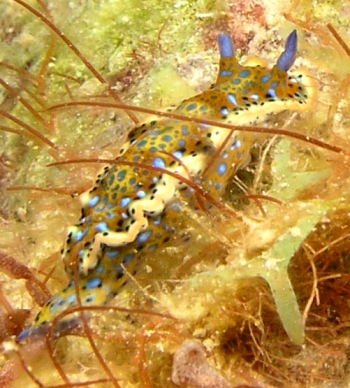
Dear Pam,
That was a nice find - as I have discussed before, I am pretty sure this is a colour form of Hypselodoris bayeri, but more work needs to be done on the Caribbean species before we really understand what is going on.
Best wishes,
Bill Rudman
Re: Hypselodoris bayeri ? from Bonaire
July 18, 2008
From: Ellen Muller
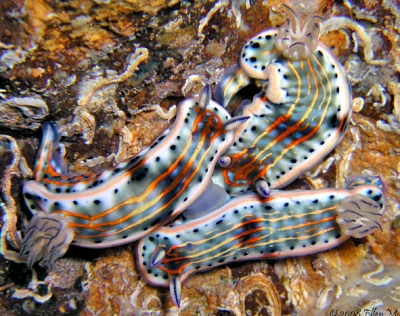
Hi Bill,
Here are some photos of hypselodorids, named 'Hypselodoris sp. 3.' in the book "Caribbean Sea Slugs " (Valdes, Hamann, Behrens, DuPont), They were found under the Town Pier in Bonaire [Lesser Antilles, Caribbean] at a depth of 20 ft. and ranged in size from 1/2 inch to 1 1/2 inches. Linda Baker found the first one on May 10th 2008, 9:30pm on a discarded grape stem. I went back 2 nights later and found two of them on a discarded plastic fork that had some encrusting sponges growing on it. May 14th, 2008, 10 pm. I found 4 individuals. A pair was mating and I also found 2 egg coils. May 18th, 2008 I found a few more individuals and also saw a pair mating. I have included some photos of them mating and one of the egg coils.
Best regards,
Ellen Muller
ellen@imaginebonaire.com
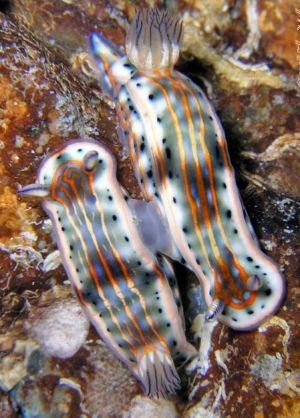
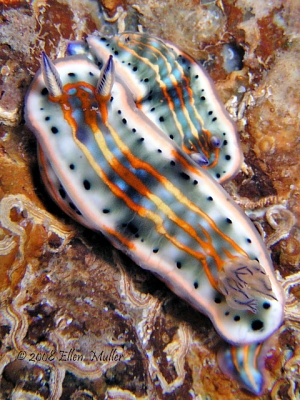
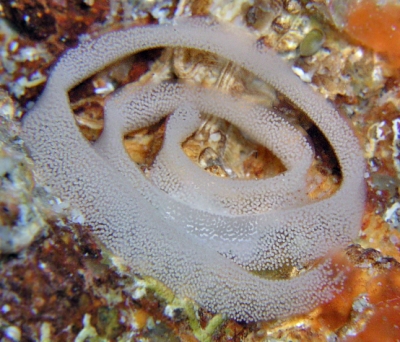
Dear Ellen,
Thanks for this valuable observation. This animal belongs to a somewhat confusing group of species which are still not sorted out. I think the most likely situation is that some of these 'species' were described from single specimens, which in fact represented colour variations of just one species with a very variable colour pattern. The most obvious difference is that in some animals there are yellow-brown and blue longitudinal lines while in others the blue can be reduced to a scattering of spots and the rest of the background becomes yellow-brown. Phillip Gillette's photos [message #13022 ] give a good example showing the blue lines breaking up into spots.
I may be quite wrong, as another feature of chromodorids is that species sometimes mimic other species in appearance, so it is possible we are looking at a case of mimicry. If they are different species, then hopefully some of these colour differences can be linked to anatomical differences, but sometimes anatomical differences are too subtle to be useful. Your inclusion of an egg ribbon however is very valuable, because often egg masses can give us a clue. Hopefully, in time, other egg ribbons, which can be identified to particular colour forms will be found. I also note in Caribbean Sea Slugs that this colour form is reported to feed on a blue sponge of the genus Dysidea. If you have any photos showing the sponge you found these animals on, it could be an interesting addition. Species of Dysidea are the usual food of species of Hypselodoris but there is always a possibility that one of the 'colour forms' of this blue-lined/blue-spotted group eats a different type of sponge.
Best wishes,
Bill Rudman
Chromodorid from Bonaire
October 17, 2007
From: Per Lagerberg
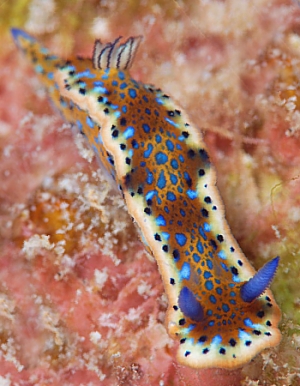
Please help me identify this one
Locality: Bonaire, Playa Funchi, 15 metres, Atlantic Ocean, 12 September 2007, on top of coral. Length: 20 mm. Photographer: Per Lagerberg.
Per Lagerberg
haytand@hotmail.com
Lagerberg, P., 2007 (Oct 17) Chromodorid from Bonaire. [Message in] Sea Slug Forum. Australian Museum, Sydney. Available from http://www.seaslugforum.net/find/20967Dear Per,
This species is on the Forum from Bonaire as Hypselodoris sp 5 [#9824] but it is also identified as H. bayeri. I am afraid it is one of a group of Caribbean species which were not well defined when they were first named. As we know very little about their colour variability it is still almost impossible to decide how many species there are. Other possible names are H. marci and perhaps H. acriba.
Best wishes,
Bill Rudman
Hypselodoris bayeri from Honduras
June 27, 2006
From: Florent Charpin
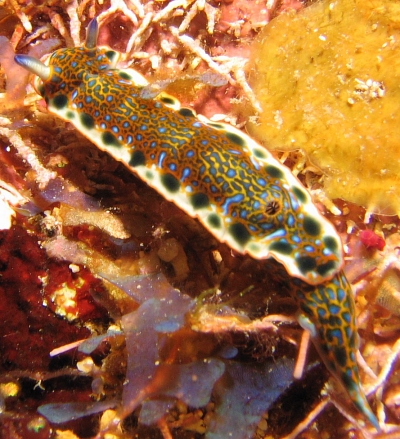
Hi Bill
I found this nudibranch in Roatan, Honduras. Is this what you refer to as Hypselodoris sp. 5?
Locality: Near Milton Bight, 40 feet, Roatan, Honduras, Caribbean Sea, 29 April 2006. Length: 1 in.. Photographer: Florent Charpin.
Thanks,
Florent
florent@charpin.net
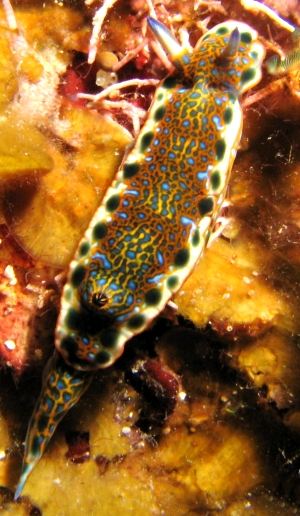
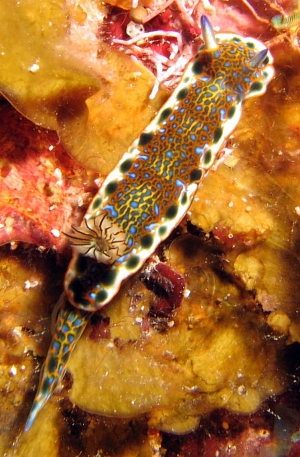
Dear Florent,
Thanks for these photos. Although they look a bit like Hypselodoris sp. 5, this is one of the colour forms of Hypselodoris bayeri On fact your animals looks very similar to the photo accompanying Marcus & Marcus's original description of the species. It suggests that the rhinophores can vary in colour from uniform purple all over, the animals like this where the purple is mainly concentrated near the tip. Looking at your photos, I suspect that animals in earlier messages from St Kitts [#12949] and Honduras [#15451] which I tentatively considered Hypselodoris sp. 5. are almost certainly H. bayeri.
One of the reasons I welcome more photos of species already present on the Forum is that every variation gives us further insight into understanding the full picture
Best wishes,
Bill Rudman
Hypselodoris acriba or H. bayeri?
June 19, 2006
From: Valda Bromfield
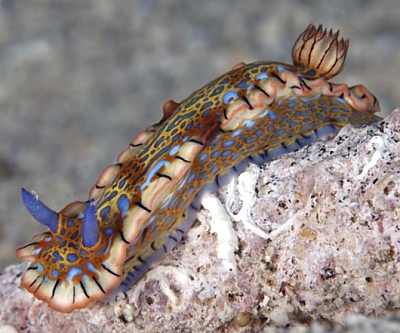
Dear Bill
I have been unable to identify this nudibranch in any of Paul Humann's ID books and were hoping that you could help me. Said speciman was moving rapidly over a course sandy bottom. I hope I have sent you enough information.
Locality: The Chimney - Great Dog Island, 45 feet, British Virgin Islands, Caribbean, 24 January 2006, sandy bottom near coral. Length: 1.75 inches. Photographer: Valda Bromfield.
Thank you,
Valda
steval@surfbvi.com
Bromfield, V, 2006 (Jun 19) Hypselodoris acriba or H. bayeri?. [Message in] Sea Slug Forum. Australian Museum, Sydney. Available from http://www.seaslugforum.net/find/16899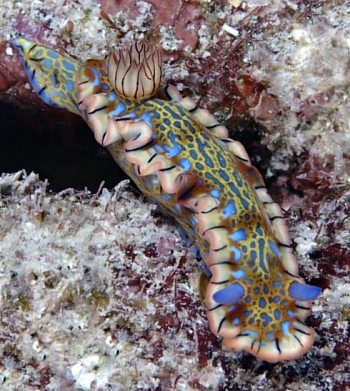
Dear Valda,
Your animal exactly matches a photo Eveline Marcus sent me [message #7999] which she identified as H. bayeri. It was also from the Virgin Islands. As I mention in the earlier message the main difference between this colour form and the one described by Marcus & Marcus (1967), when they named this species, is that it had a pattern of dark blue spots around the mantle edge rather than the radiating lines of your animal. However in a photo from Florida [#13022] we can see an animal with a spotted margin, but also with some small radiating lines suggesting this is a variable feature, as did Eveline Marcus.
Since we know so little about these species, your photo is a valuable contribution to our knowledge. It will be interesting to whether similar links been H. bayeri and H. acriba turn up, as there are many similarities between these two species.
Best wishes,
Bill Rudman
Hypselodoris sp. 5 from Honduras
December 14, 2005
From: Les Wilk
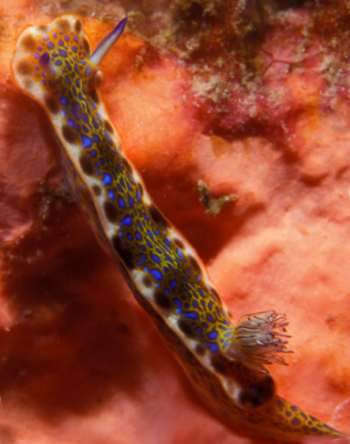
Hi Bill;
I believe these are photos of what you refer to as Hypselodoris sp. 5.
Locality: Utila Island, Honduras, Caribbean. Depth: 40 feet. Length: 0.75 inch. July 2000. reef. Photographer: Keri Wilk
Les Wilk
wilk@reefnet.ca
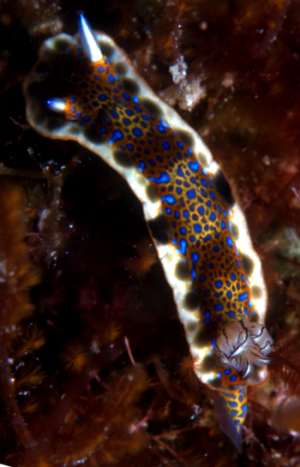
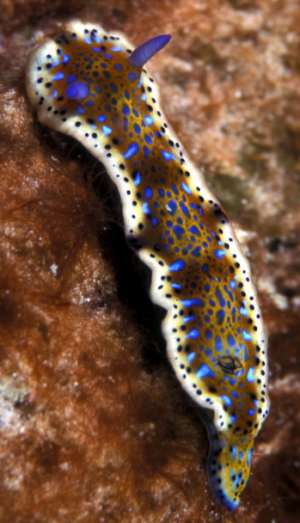
Note added 26 June 2006: This is almost certainly a colour form of H. bayeri. See message #16979]
Thanks Les,
Yes this is what I am calling Hypselodoris sp. 5. Interestingly your animals show differences in the colour of the mantle border - small spots in one, large blotches in the other, and possibly differences in the rhinophore colours. I wouldn't be surprised if Hypselodoris sp. 5 and H. bayeri, and perhaps H. marci, turn out to be forms of one species, but unfortunately the two named species were not well described, so its difficult to know what they are. Combine that with the fact that we don't know whether we are dealing with one variable species of a number of similarly coloured species, and you get an idea of the problem. This problem is not going to be solved by someone giving names to a few apparently distinct colour forms. What we need is someone to study populations of these animals throughout the Caribbean, I am sure if there are really different species it will show up in different egg ribbons, development types, or even food choice.
Best wishes,
Bill Rudman
Colour variant of Hypselodoris sp. 5 from St Kitts
February 4, 2005
From: Kelly Griggs
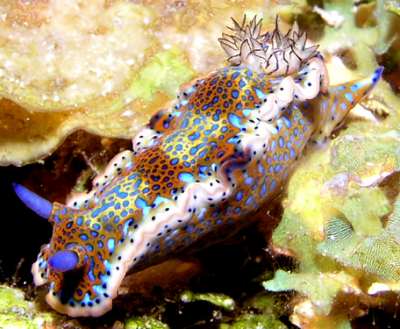
I found this guy in St. Kitts at a site called Coconut Reef on 31 December 2004. It was at a depth of 60 feet crawling along the reef. It appears similar to Hypselodoris sp. 5, a various similar to the one from 'Brian' photographed in Bonaire [message #9824 ]. Notice the solid blue rhinopores. Have any updates to this particular species been made? Is it possible to be a different color variation of the same species? Many thanks for your help.
Locality: Coconut Reef , St. Kitts, Caribbean. Depth: 60 feet. Length: 1 inch approx. 31 December 2004. - on the reef (sand bottom). Photographer: Kelly Griggs
Kelly Griggs
Georgia, USA
k_griggs@hotmail.com
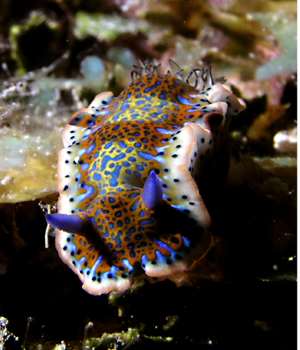
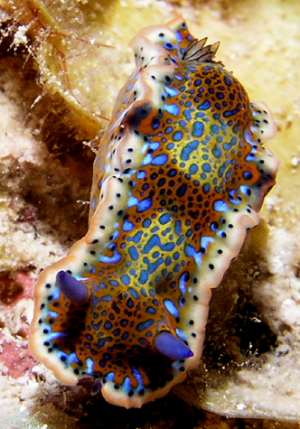
Note added 26 June 2006: This is almost certainly a colour form of H. bayeri. See message #16979]
Dear Kelly,
Thanks for these photos. We have had a few good photos of Caribbean chromodorids in the last couple of days. I am afraid there are no easy answers at the moment. I wonder whether your animal is an an extreme colour form of Hypselodoris bayeri as illustrated in Phillip Gillette's recent message [#13022] ? I am not sure if Hypselodoris sp. 5 is a good species. Perhaps there are two? I agree the white rhinophores with purple tips that some specimens have seems distinctive but there are others with pale purple rhinophores with deeper purple tips. Clearly we need more information on these animals, so photos such as yours are very useful.
Best wishes,
Bill Rudman
Hypselodoris bayeri from Florida
February 3, 2005
From: Phillip Gillette
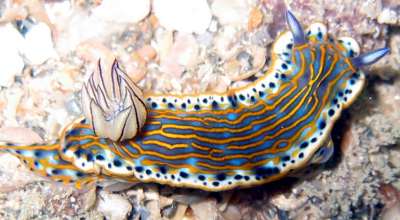
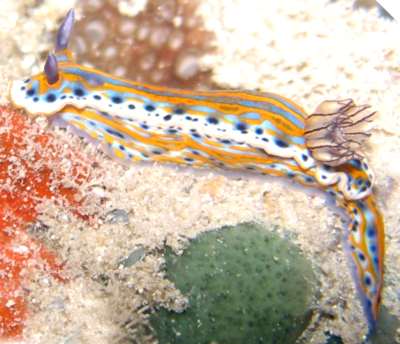
Dear Bill,
Here are some photos of Hypselodoris bayeri from Florida.
Locality: Virginia Key, Biscayne Bay, Florida, USA. Depth: 20 ft. Length: 2-3 cm. Photographer: Phillip Gillette.
Best wishes
Phillip
pgillette1@hotmail.com
Gillette, P., 2005 (Feb 3) Hypselodoris bayeri from Florida. [Message in] Sea Slug Forum. Australian Museum, Sydney. Available from http://www.seaslugforum.net/find/13022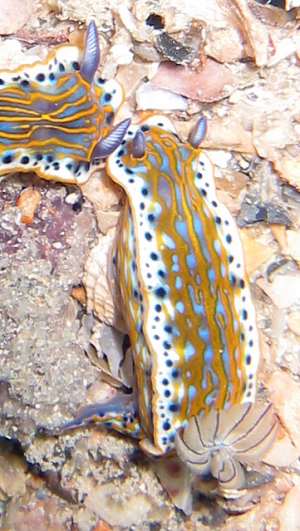
Dear Phillip,
Thanks for these photos. As you will have noted from the correspondence on the Forum I have had my doubts about many of the animals identified as H. bayeri in the literature. None of them have fitted the original description very well. These photos of yours do indeed fit Marcus' description almost exactly. The colour obviously varies from animals with a number of thin yellow longitudinal lines down the mantle, each outlined in black as in Marcus's description (and your uppermost photo), to animals in which the yellow lines are less clear and the blue spots more dominant, as in your photo alongside.
Best wishes,
Bill Rudman
Re: Hypselodoris from Bonaire (Caribbean)
May 27, 2003
From: Ron Velarde
Dear Bill/ Brian,
In looking at all the photos and comparing, it looks to me that there could be at least three species here. Hypselodoris bayeri, as shown by the Marcus photo; Hypselodoris sp 5, as shown, except I think Brian's photo is a THIRD species, as the rhinophores are purple with darker tips as opposed to white with blue tips. Also, it looks to me like Dave Behren's Hypselodoris bayeri from Belize is Hypselodoris sp 5. As always, identifications from photos without specimens is opinion at best but this is what I see. Is there any size data to go along with the photos? (ie. could color differences be size related?)
Ron Velarde
rvelarde@sandiego.gov
Velarde, R., 2003 (May 27) Re: Hypselodoris from Bonaire (Caribbean). [Message in] Sea Slug Forum. Australian Museum, Sydney. Available from http://www.seaslugforum.net/find/10005Thanks Ron,
We still have a lot more to learn about this group. Almost every photo I get seems a bit different. I decided to treat the light purple rhinophore with a dark purple tip in Brian's photo to be a 'dark form' of those with a white rhinophore with a purple tip - but I could be wrong. We have two problems. Firstly we can't be sure of the colour pattern of the type specimens Marcus' species. Secondly we have no idea how many species we are dealing with and just how variable they are in colour. I'm afraid I put any data I get with photos so I'm afraid at thois stage we can't say whether colour variation is size related.
best wishes,
Bill Rudman
Hypselodoris bayeri? from Colombia
February 23, 2003
From: Néstor E. Ardila
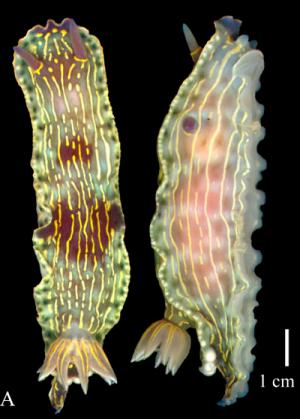
Dear Bill,
Here are some photos of a specimen of Hyoselodoris bayeri, which was collected with a bottom trawl, off Dibulla, Colombia at approx 70 m depth. It was 45 mm long alive.
I have sent photos of the radula and jaw plates in a separate message.
The colour pattern of the notum is deep blue with longitudinal yellow lines edged with black. The margin of the notum is white, containing black spots of different size and bordered by a yellow line externally. There is a yellow margin to the rhinophore pockets. The rhinophores are deep blue.
There has been a big confusion with the coloration of this species, probably because of the erroneous identification made by Thompson (1977, 1980) for material recorded from Jamaica.
Néstor E. Ardila
nardila@invemar.org.co
![]()
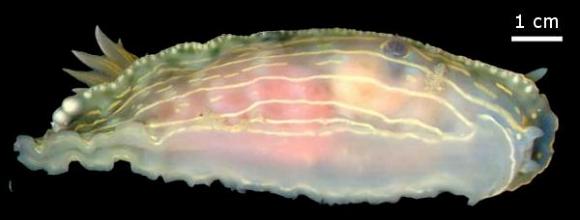
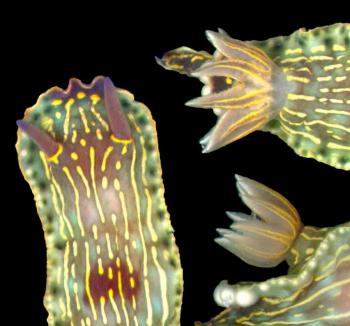
Dear Néstor,
It's good to get some more information on this group of species. I don't think the confusion surrounding this group of species can be blamed on Thompson's misidentification, which is on the Forum as Hypselodoris sp 5. The confusion is caused by the original description being based on two specimens, which in a species with a variable colour pattern is an inadequate sample. Clearly the Caribbean region has a group of similarly coloured species which are still not adequately understood.
Looking at your photos, I am now beginning to wonder whether the two animals that Marcus & Marcus had available to them when they described H. bayeri are in fact the same species. Your animal looks like Marcus & Marcus's colour plate Pl 1, fig 2, while the line drawing, Fig 76 [which was based on a colour slide of a second specimen], has a more reticulate pattern of yellow like the animal in Dave Behrens' message.
One thing that makes me wonder if there are two species is that in some photos the gills seem simple with a black or dark blue line up the outer edge, while in other photos, such as yours, the gills are really triangular in outline with the outer face being pale purple or blue and the edges bright yellow. This is not always easy to determine from slides, so I am not sure which gill type Marcus & Marcus were describing. We also don't know which of their two specimens they based their colour description on. The only way this can be sorted out is for a lot more Caribbean animals to be studied in detail.
I wouldn't be at all surprised if your animal turned out to be the one I am calling Hypselodoris sp. 4, although in most photos it seems to have a series of pale spots down the outer face of each gill. Another animal with a close similarity to your animal - including the yellow edging to the gills - is illustrated in Humann, 1999 [p. 233] as Hypselodoris acriba.
Thanks for these interesting photos. I have kept your latero-ventral photo at a larger size because it shows the arrangement of the mantle glands very well. Thanks also for the radula photos in your other message.
Best wishes,
Bill Rudman
Radula of Hypselodoris bayeri?
February 23, 2003
From: Néstor E. Ardila
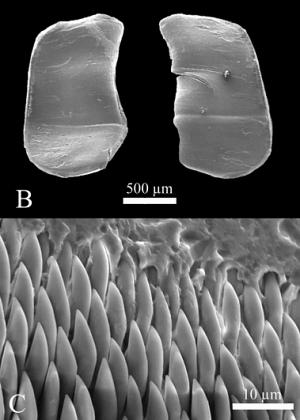
Dear Bill,
To accompany my other message, here are some SEM photos of the radula and jaw plates of the specimen.
B. whole jaw plates
C. jaw rodlets
D. outermost radular teeth on left side.
E. outer view of midlateral teeth n left side.
F. radular tooth near outer edge on right side.
G. outer view of midlateral teeth from right side.
Néstor
nardila@invemar.org.co
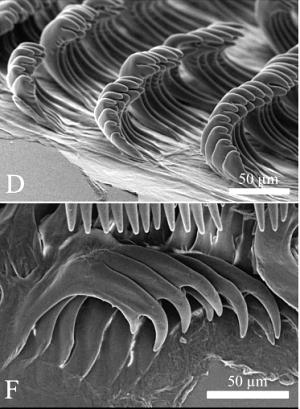
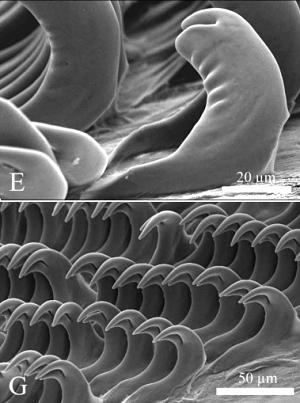
Dear Néstor,
Thanks for these photos. They look very like the teeth illustrated by Marcus & Marcus in their original description. However they described an aberrant first lateral tooth as a central tooth and used this character to erect a new genus Felimare.
best wishes,
Bill Rudman
Hypselodoris bayeri from Belize
September 27, 2002
From: Dave Behrens
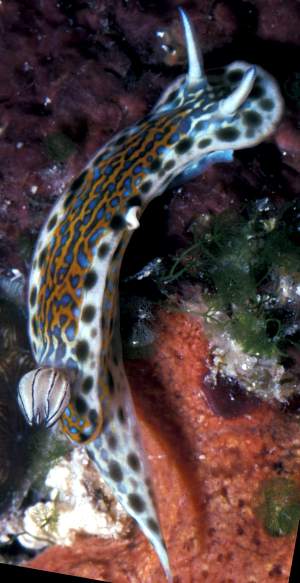
Dear Bill:
Thank you for posting Eveline's photo of H. bayeri. This species has always bothered me. Here is a specimen I collected in the mangroves at Lark Cay, Belize, several years ago. For some time we considered it an undescribed species, but now have come around to the opinion it is the Marcus' Hypselodoris bayeri. The photograph was taken by Jeff Hamann. Since that time I have collected it in Honduras, also.
Comparing Eveline's photo with the photo in Humann's Reef Creatures Guide and this photo, we have a better feel for the variation and consistencies in mantle coloration. Concerning its similarity to Hypselodoris acriba, I have collected it from the same region, and believe the two species to be distinct.
p.s. Please note that is a parasitic copepod on edge of mantle, not an aberration.
Thanks again.
Dave Behrens
dave@seachallengers.com
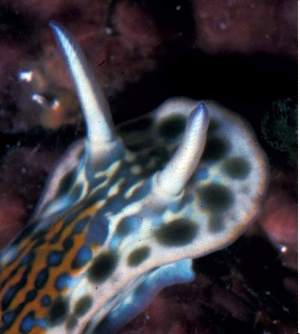
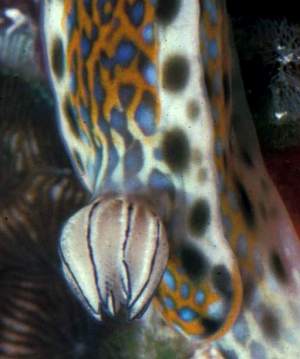
Thanks Dave,
The black spots around the edge of the mantle in Jeff Hamann's photo are certainly more as described by the Marcus's than in the photo I posted, and the rhinophores in Jeff's photo show only a hint of the spectacular blue of the other photo. I hesitated about posting the Marcus' photos, as I didn't know who the photographers were, and there was little accompanying data, so I am glad you have found them useful.
Cheers,
Bill Rudman
Hypselodoris bayeri - Marcus photo
September 23, 2002
From: Bill Rudman
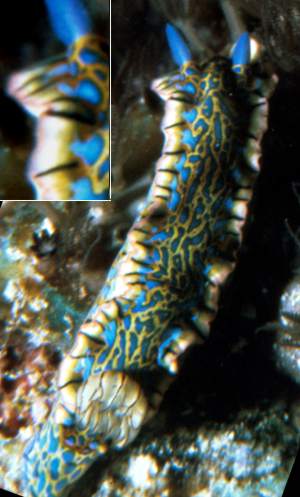
After posting the recent photos of Hypselodoris sp 5 from the Caribbean. I remembered Eveline Marcus had sent me a few slides of central American chromodorids many years ago.
This photo given to me by her in Dec 1984, identified as Hypselodoris bayeri. The only accompanying data was 'St John, Virgin Ids, Caribbean.' No photographer was identified. I have included this photo as it gives us an idea of Eveline Marcus's concept of this species.
The animal photographed here, from the Virgin Ids, differs in having the yellow lines on the dorsum forming a reticulate pattern while in the photograph of the holotype the yellow lines form a parallel series with only a few cross connections. The other difference is that in the original animal there are small dark spots around the mantle border while in the Virgin Id animal they are replaced by dark transverse lines. Despite these differences, I have included this photo since it was identified as H. bayeri by Eveline Marcus. This species has considerable similarities to Hypselodoris acriba which was described by the same authors in the same paper. Possibly the two species are just colour extremes of the same species.
-
Marcus, Er. & Marcus, Ev. (1967) American opisthobranch mollusks. Part 1, Tropical American opisthobranchs. Studies in Tropical Oceanography, Miami, 6(1-2): 1-137. (Figs 1-150, Pl.1, figs 1-9).
Best wishes
Bill Rudman
